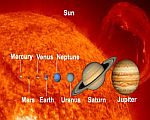Very Small Numbers - measurements at the subatomic level
Very small numbers have to be brought into play when considering the size of objects at the subatomic scale. We all know that the smallest measurement found on a common school ruler is one millimetre. But, what if we were to subdivide that millions and millions of times? We'll consider lengths going ever smaller, until we reach the smallest measurement possible.
The Nanometre
When considering these very small numbers, some sort of shorthand has to be employed when writing them down, to avoid long strings of zeros. Thus the millimetre, which is one thousandth of a metre, could be represented as 1x10-3m.
Many of you may have heard of nanotechnology, which is the direct manipulation of matter at the atomic level. The name comes from the unit of length, the nanometre. This can be represented as 1x10-9 and is one millionth of a millimetre.
Angstrom Unit
More correctly spelt Ångström, as it is named after Swedish physicist Anders Ångström, this is a measurement used in describing the dimensions of atoms. It is one tenth the distance of a nanometre, or one 10 millionth of a millimetre.
It is represented as 1x10-10m. The radius of a hydrogen atom is 0.25Å.The Picometre
We're reaching very small numbers now. This unit of measurement spans a mere 1x10-12 and is thought to be the longest possible wavelength of a gamma ray.
The Femtometre
With a value of 1x10-15, this distance represents dimensions at the atomic level. It is thought to cover the scale of the atomic nucleus.
Getting Ever Smaller
By now, we've reached one million millionth of a millimetre! But, unbelievably, there's a long way to go yet before we reach the limit of smallness.
Next, we have the attometre, at 1x10-18, the zeptometre, at 1x10-21 and the yoctometre, a tiny 1x10-24.At these levels, we're dealing with the sizes of things like quarks and neutrinos, some of the smallest possible particles.
The Planck Length
Here, at long last, is the smallest measurable length possible. It is thought that any lengths smaller than this would cease to have any meaning.
At an impressive 1.62x10-35, it is derived from the speed of light, Planck's constant and the cosmological constant. It deserves to be written out in full, to give you more of an idea how small it is.How about 0.00000000000000000000000000000000162 metres.
To give you more of an idea, imagine a dot . that was expanded to be the size of the observable Universe. One Planck length within it would be the size of the original dot.
It is at the Planck length scale that interactions of the strings in string theory are thought to take place.









Facebook Comments
Have your say about what you just read! Leave me a comment in the box below.